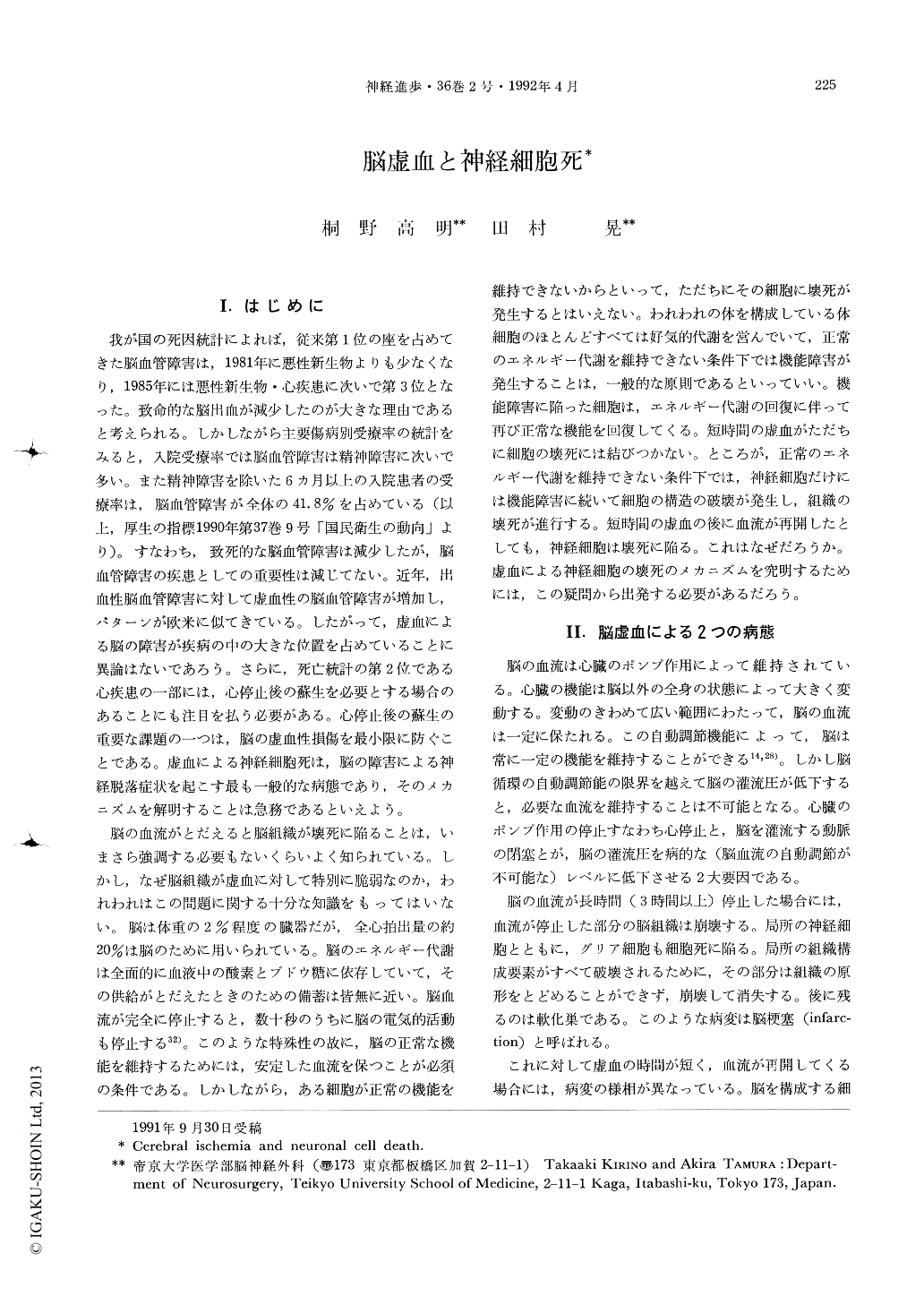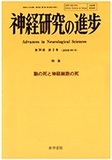Japanese
English
- 有料閲覧
- Abstract 文献概要
- 1ページ目 Look Inside
I.はじめに
我が国の死因統計によれば,従来第1位の座を占めてきた脳血管障害は,1981年に悪性新生物よりも少なくなり,1985年には悪性新生物・心疾患に次いで第3位となった。致命的な脳出血が減少したのが大きな理由であると考えられる。しかしながら主要傷病別受療率の統計をみると,入院受療率では脳血管障害は精神障害に次いで多い。また精神障害を除いた6ヵ月以上の入院患者の受療率は,脳血管障害が全体の41.8%を占めている(以上,厚生の指標1990年第37巻9号「国民衛生の動向」より)。すなわち,致死的な脳血管障害は減少したが,脳血管障害の疾患としての重要性は減じてない。近年,出血性脳血管障害に対して虚血性の脳血管障害が増加し,パターンが欧米に似てきている。したがって,虚血による脳の障害が疾病の中の大きな位置を占めていることに異論はないであろう。さらに,死亡統計の第2位である心疾患の一部には,心停止後の蘇生を必要とする場合のあることにも注目を払う必要がある。心停止後の蘇生の重要な課題の一つは,脳の虚血性損傷を最小限に防ぐことである。虚血による神経細胞死は,脳の障害による神経脱落症状を起こす最も一般的な病態であり,そのメカニズムを解明することは急務であるといえよう。
脳の血流がとだえると脳組織が壊死に陥ることは,いまさら強調する必要もないくらいよく知られている。しかし,なぜ脳組織が虚血に対して特別に脆弱なのか,われわれはこの問題に関する十分な知識をもってはいない。脳は体重の2%程度の臓器だが,全心拍出量の約20%は脳のために用いられている。脳のエネルギー代謝は全面的に血液中の酸素とブドウ糖に依存していて,その供給がとだえたときのための備蓄は皆無に近い。脳血流が完全に停止すると,数十秒のうちに脳の電気的活動も停止する32)。このような特殊性の故に,脳の正常な機能を維持するためには,安定した血流を保つことが必須の条件である。しかしながら,ある細胞が正常の機能を維持できないからといって,ただちにその細胞に壊死が発生するとはいえない。われわれの体を構成している体細胞のほとんどすべては好気的代謝を営んでいて,正常のエネルギー代謝を維持できない条件下では機能障害が発生することは,一般的な原則であるといっていい。機能障害に陥った細胞は,エネルギー代謝の回復に伴って再び正常な機能を回復してくる。短時間の虚血がただちに細胞の壊死には結びつかない。ところが,正常のエネルギー代謝を維持できない条件下では,神経細胞だけには機能障害に続いて細胞の構造の破壊が発生し,組織の壊死が進行する。短時間の虚血の後に血流が再開したとしても,神経細胞は壊死に陥る。これはなぜだろうか。虚血による神経細胞の壊死のメカニズムを究明するためには,この疑問から出発する必要があるだろう。
Fatal cerebrovascular disorders has decreased in number gradually, and cerebrovascular diseases (CVD) are no longer the commonest cause of death in Japan since 1981. However, CVD still remain the most frequent disabling disease entity. The brain is particularly susceptible to ischemia. Brain loses its normal function immediately following cessation of cerebral blood supply. It is not fully understood, however, why the loss of normal function following ischemia rapidly shifts to structural breakdown and necrosis of neurons. When cerebral ischemia is severe and prolonged, brain tissue falles into infarction. Neurons and glial cells die in ischemic core region. This pathological process is the typical change in focal cerebral ischemia due to obstruction of major cerebral arteries. When ischemia is transient and brief, even if it is severe, total tissue necrosis does not develop. Neurons are selectively damaged and removed in this case. This selective neuronal necrosis is usually seen in cases with global cerebral ischemia, mostly due to cardiac arrest. Following transient, brief ischemia, the most vulnerable groups of neurons are selectively injured. Pyramidal cells of the hippocampal CA1 sector and Purkinje cells in the cerebellum have been known to be the most susceptible.

Copyright © 1992, Igaku-Shoin Ltd. All rights reserved.


